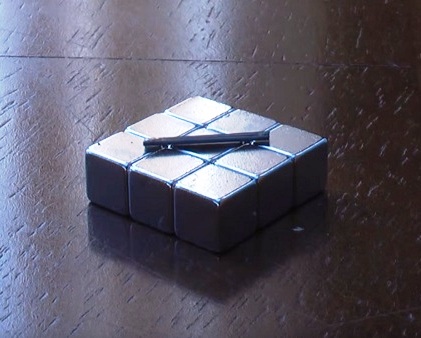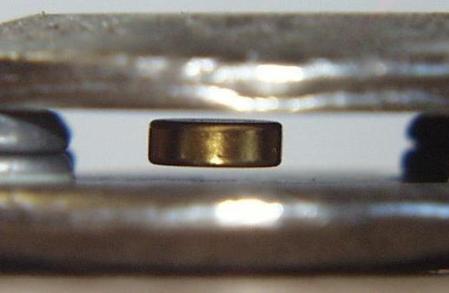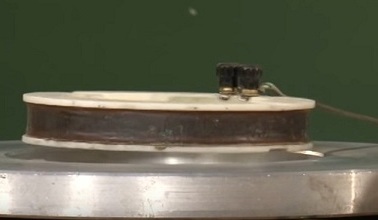Categories: Featured Articles » Interesting Facts
Number of views: 37269
Comments on the article: 0
Magnetic levitation - what is it and how is it possible
The word "levitation" comes from the English "levitate" - to soar, to rise into the air. That is, levitation is the overcoming by the object of gravity when it soars and does not touch the support, without repelling from the air, without using jet propulsion. From the point of view of physics, levitation is a stable position of an object in a gravitational field, when gravity is compensated and a restoring force takes place, which provides stability to the object in space.
In particular, magnetic levitation is the technology of lifting an object using a magnetic field, when magnetic action on an object is used to compensate for the acceleration of gravity or any other acceleration. It is about magnetic levitation that will be discussed in this article.

Magnetic retention of an object in a state of stable equilibrium can be realized in several ways. Each of the methods has its own peculiarities, and claims can be made to each, such as “this is not real levitation!”, And so it really will be. True levitation in its pure form is unattainable.
So, the Earnshaw theorem proves that, using only ferromagnets, it is impossible to stably hold an object in a gravitational field. But despite this, with the help of servomechanisms, diamagnetics, superconductors and eddy current systems, it is possible to achieve a semblance of levitation when some mechanism helps the object maintain equilibrium when it is raised above the support by magnetic force. However, first things first.
Electromagnetic levitation with tracking system
Applying a circuit based on an electromagnet and a photorelay, you can make levitate small metal objects. The item will float in the air at some distance from the electromagnet fixed on the rack. The electromagnet receives power until the photocell mounted in the rack is obscured by a soaring object, until enough light gets from it from a fixed control source, which means that the object must be pulled.

When the object is sufficiently raised, the electromagnet is switched off, because at this moment the shadow from the object moved in space falls on the photocell, blocking the light of the source. The object begins to fall, but does not have time to fall, as the electromagnet is switched on again. So, by adjusting the sensitivity of the photo relay, you can achieve an effect in which the object will somehow hang in one place in the air.
In fact, the object is constantly falling, then again slightly raised by the electromagnetic. It turns out the illusion of levitation. This principle is based on the work of “levitating globes” - rather unusual souvenirs, where a magnetic plate is attached to the globe, with which an electromagnet, hidden in a stand, interacts.
Diamagnetic levitation

Graphite lead from a simple pencil is a diamagnet, that is, a substance that is magnetized against an external magnetic field. Under certain conditions, the magnetic field is completely displaced from the material of the diamagnet, for example, graphite lead has a high magnetic susceptibility, and begins to soar above neodymium magnets even at room temperature.
For stability of the effect, magnets should be staggered (magnet poles), then the graphite rod will not slip out of the “magnetic trap” and will levitate.

A rare-earth magnet with an induction of only 1 T can hang between bismuth plates, and in a magnetic field with an induction of 11 T, the “levitation” of a small neodymium magnet can be stabilized between the fingers, since human hands are a diamagnet, like water.

A fairly widespread experience with a levitating frog is known. The animal is carefully placed over a magnet, which creates a magnetic induction of more than 16 T, and the frog, demonstrating diamagnetic properties, actually freezes in the air at a short distance from the magnet.
Magnet levitation over a superconductor (Meissner effect)
The yttrium-barium-copper oxide plate is cooled to the temperature of liquid nitrogen. Under these conditions, the plate becomes a superconductor. If you now put a neodymium magnet on a stand above the plate, and then pull out the stand from under the magnet, then the magnet will hang in the air - it will levitate.
Even a small magnetic induction of the order of 1 mT is enough for the magnet, when placed on the plate, to rise a few millimeters above the cooled high-temperature superconductor. The higher the induction of the magnet, the higher it will rise.

The point here is that one of the properties of a superconductor is the expulsion of the magnetic field from the superconducting phase, and the magnet, repelling from this magnetic field of the opposite direction, floats up and continues to soar above the cooled superconductor until it leaves the superconducting state.
Eddy Current Levitation
Eddy currents (Foucault currents) induced by alternating magnetic fields in massive conductors are also able to keep objects in a levitating state. For example, an alternating current coil can levitate over a closed aluminum ring, and an aluminum disk will hover above an alternating current coil.


The explanation here is this: according to Lenz’s law, the current induced in the disk or in the ring will create such a magnetic field that its direction will hinder the cause of it, that is, in each period of alternating current oscillations in the inductor, a magnetic field of the opposite direction will be induced in the massive conductor . So, a massive conductor or coil of a suitable shape can levitate all the time while the alternating current is on.

A similar retention mechanism occurs when Neodymium magnet drop inside a copper pipe - the magnetic field of the induced eddy currents is directed opposite to the magnetic field of the magnet.
See also at bgv.electricianexp.com
:
